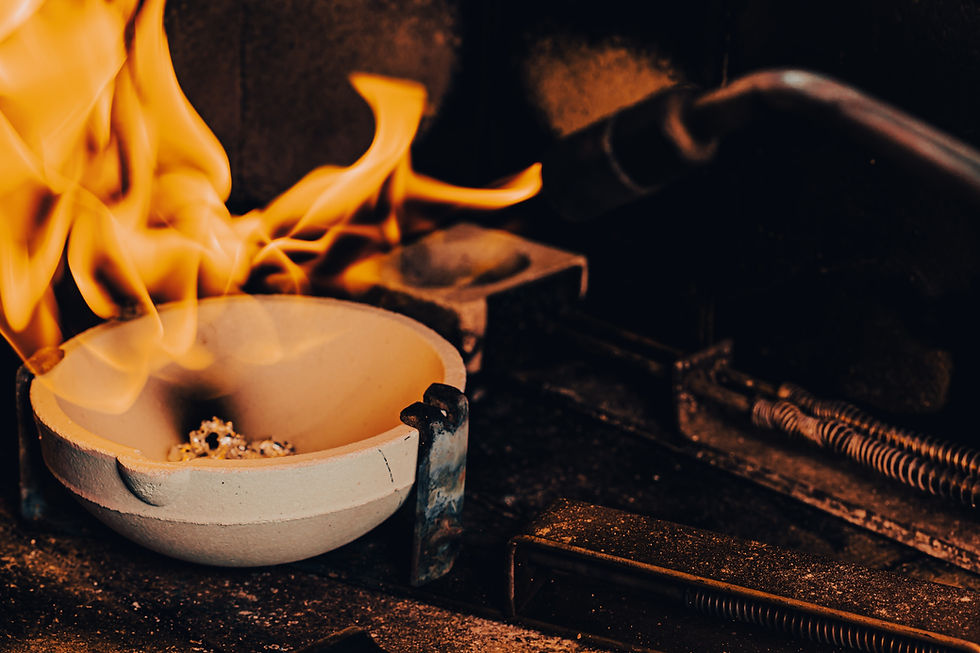Cupellation: Alchemy Process of Metals
- Sylvia Rose

- Jul 22, 2024
- 4 min read
Cupellation is an ancient alchemy process used in metal separation. Alchemy comes from metallurgy and early medicine. The processes of chrysopoeia (gold-making) and silver-making (argyropoeia) are popular since the ancient days of Alexandria, on the Mediterranean Sea.

Cupellation is an essential procedure of metallurgy for extracting and purifying metals such as silver and gold. The method involves exposing ores or alloyed metals to high temperatures in a controlled setting.
This technique separates noble metals like gold and silver from base metals such as lead, copper, zinc, antimony, arsenic, or bismuth in the ore. While terms base and noble for metals don't exist until the 14th century, metals are already seen as such due to their properties.

The cupellation process depends on the unique characteristics of these metals, causing the precious metals to separate into a distinct phase because of their resistance to oxidation, while the less valuable metals are oxidized and removed as waste.
This procedure requires precision and skill to guarantee the effective separation of the sought-after precious metals. In the production of high-quality gold and silver, cupellation is seen as a crucial step.

Precious metals typically oxidize or react chemically at higher temperatures than base metals. When they are heated at high temperatures, the precious metals separate and others react, forming slags or different components.
Since the Early Bronze Age, cupellation is used to obtain silver from smelted lead ores. By the Middle Ages and the Renaissance, cupellation is one of the most common processes for refining precious metals.

One of the defining characteristics of small-scale cupellation is the use of small shallow vessels or cupels. Made of porous material like bone ash or magnesia, cupels ease absorption of lead and other impurities, leaving behind the desired noble metals.
The cupel, a crucial tool in small-scale cupellation, is designed as a small vessel resembling an inverted truncated cone, often crafted from bone ash. According to some, the superior material for cupel production is burnt deer antlers or fish spines, both high in calcium.

By then, fire assays were used for assaying minerals: testing fresh metals such as lead and recycled metals to determine their purity for jewelry and coin making. Cupellation is still in use today.
Small-scale cupellation, as used by the alchemist, involves treatment of a reduced quantity of material compared to industrial level. The procedure uses a series of steps such as crushing, roasting and smelting to concentrate metallic components such as noble metals for separation.

In the Renaissance, cupellation techniques are widely used for diverse applications ranging from ore assaying to evaluating silver content in jewelry or coins. The methods are also common in experimental studies to investigate properties and behaviors of various metals.
Preparation of the ashes involves thorough grinding and mixing with a sticky substance such as mud, clay or dung to facilitate formation of the cupels. The cupels are shaped in copper or brass molds, without bases to ensure easy removal.

During the manufacturing process a slight depression is made in the center of the cupel, using a rounded pestle. Controlled heating of the cupel allows separation of metals, a valuable step in refining and analyzing precious materials.
Small-scale cupellation is a fundamental technique in metallurgy and analytical chemistry and reliable method for extracting and purifying precious metals. Its significance extends beyond practical applications.

Scientific exploration and discovery reflecting the ingenuity and resourcefulness of early craftsmen and alchemists. This traditional cupel design is still used today.
The first known use of silver was in the Near East in Anatolia and Mesopotamia during the 4th and 3rd millennium BCE or the Early Bronze Age. Archaeological findings of silver and lead objects together with litharge pieces and slag have been studied at a variety of sites.

Although this has been interpreted as silver being extracted from lead ores, it has been also suggested that lead was added to collect silver from visible silver minerals embedded in host rock. In both cases silver would be retrieved from lead metal by cupellation.
During the Iron Age, cupellation is done by fusing base metals with a surplus of lead. The bullion or product of this fusion is then heated in a cupellation furnace to separate the noble metals.

During the Roman times, the empire needs large amounts of lead to support civilization over a wide region. In conquered lands, they search for open lead-silver mines. Silver coins become the normalized medium of exchange
Silver production and mine control gives economic and political power. In Roman times it's worth mining lead ores if their content of silver is 0.01% or more.

Non-Fiction Books:
Fiction Books:
READ: Cult of the Fire God - Bronze Age Quest Adventure
READ: Lora Ley Adventures - Germanic Mythology Fiction Series
READ: Reiker For Hire - Victorian Detective Murder Mysteries


